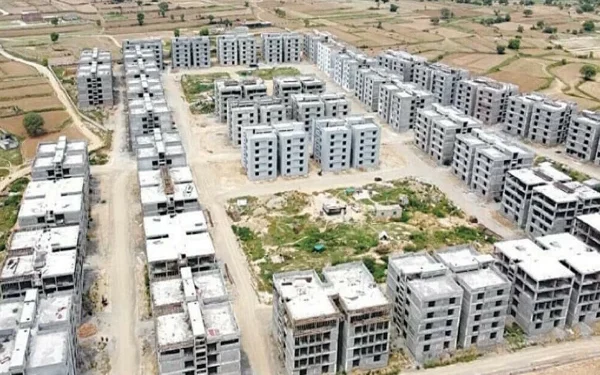Karachi: The federal government of Pakistan is preparing to launch a new subsidized housing finance scheme in the upcoming fiscal year 2025–26, with a focus on revitalizing the construction and real estate sectors and providing affordable housing solutions for the country’s low and middle-income population.
This move, coming on the heels of the discontinued “Mera Pakistan Mera Ghar” initiative, is seen as a renewed attempt to bridge the housing gap and stimulate economic growth in key urban and semi-urban areas. The new scheme is expected to offer mark-up subsidies on housing loans, easing the burden of monthly installments for aspiring homeowners.
Objectives of the New Subsidized Housing Finance Scheme
The primary goals of the new housing finance scheme are:
- To promote home ownership among the middle and lower-income groups.
- To stimulate demand in the construction and real estate sectors.
- To improve housing affordability by subsidizing the cost of financing.
- To increase the mortgage-to-GDP ratio, which currently stands at less than 1% — the lowest in the region.
- To provide economic stimulus through job creation and investment in the construction supply chain.
Background: Lessons from “Mera Pakistan Mera Ghar”
The previous scheme, Mera Pakistan Mera Ghar (MPMG), was launched in 2020 by the State Bank of Pakistan as part of a broader government strategy to address the country’s housing shortfall. It offered subsidized loans for housing units of different sizes, with fixed low-interest rates, and was initially hailed as a game-changer.
However, MPMG was eventually discontinued due to macroeconomic instability, rising inflation, high policy rates, and inconsistent funding. Despite being ambitious in vision, it struggled to deliver on ground-level implementation due to:
- Bureaucratic red tape
- Limited financial inclusion
- Lack of inter-institutional coordination
- Challenges in loan disbursement and eligibility verification
Structural Features of the New Scheme
While official documentation and policy details are yet to be finalized, several key features are expected to be part of the new housing finance scheme:
1. Markup Subsidy Model
The government is expected to provide a direct subsidy on markup rates, thereby reducing the effective interest rates for borrowers. This will make monthly installment payments more manageable for salaried individuals, daily wage earners, and small business owners.
2. Loan Limits Based on Income Brackets
Eligibility criteria may be revised to introduce income-based slabs, ensuring that the most vulnerable sections of society receive the highest level of subsidy.
3. Involvement of the State Bank of Pakistan
The scheme will be regulated under the State Bank of Pakistan (SBP), which will also be responsible for defining the risk-sharing framework with commercial banks and ensuring transparent implementation.
4. Focus on Small and Medium Housing Units
To ensure practical execution, the scheme may be focused on smaller housing units and apartment projects rather than large-scale luxury housing developments.
Challenges and Concerns
Despite its promising potential, the scheme faces several critical challenges, as outlined by economists and housing experts:
● High Land and Construction Costs
Over the past few years, land prices have soared, and the cost of construction materials like cement and steel have also risen sharply, making housing unaffordable for most low-income families.
● Limited Financial Capacity of Target Beneficiaries
A majority of the scheme’s intended beneficiaries lack the credit history or documentation needed to qualify for a formal mortgage, especially in a country with a large informal economy.
● Uncertainty About Eligibility and Structure
The lack of clarity on eligibility criteria, loan tenure, property valuation mechanisms, and loan disbursement processes could hinder the scheme’s rollout and uptake.
● Mortgage-to-GDP Ratio Concerns
As mentioned by experts, Pakistan’s mortgage-to-GDP ratio is below 1%, which is far behind regional countries like India (11%) and Malaysia (30%). This reflects the underdeveloped nature of the housing finance sector in Pakistan.
Expert Opinions and Industry Reactions
Ibrahim Amin – Real Estate Valuation & Engineering Expert
Ibrahim Amin welcomed the government’s decision, stating that the scheme comes at a time when macroeconomic indicators are improving and the State Bank is gradually reducing policy rates.
“The new housing finance scheme can stimulate real estate activity, encourage urban development, and attract both local and overseas investment,” said Amin.
He emphasized the need for transparent implementation, institutional coordination, and a robust monitoring mechanism to ensure long-term success.
Moaz Luqman – Realtor, Karachi
Moaz Luqman pointed out that Pakistan currently faces a housing shortage of 1.2 million units annually, especially in major urban centers.
“Due to unaffordable construction costs, bookings for small and mid-sized flats have declined in recent years. A subsidized finance scheme will be a win-win for both homebuyers and builders,” he said.
He added that by reducing financial barriers, the scheme can revitalize the stagnated apartment and housing project markets in cities like Karachi, Lahore, and Islamabad.
Role of Overseas Pakistanis
The scheme also aims to attract investment from the overseas Pakistani community, which has been a major source of remittances. With appropriate marketing and digital platforms, overseas Pakistanis could be encouraged to invest in approved housing projects for long-term returns or family relocation.
Policy Recommendations for Success
For the subsidized housing finance scheme to achieve its objectives, experts recommend the following:
- Public Awareness Campaigns
Educate the public, especially low-income groups, about the benefits and application process of the scheme. - Digital Platforms for Application and Tracking
Introduce digital portals to allow transparent, user-friendly, and trackable loan applications. - Collaboration with Private Sector
Encourage public-private partnerships (PPPs) to involve developers, builders, and commercial banks in a coordinated manner. - Reform in Land Management and Title Verification
Introduce reforms to streamline property title verification and reduce land-related legal disputes. - Monitoring and Evaluation Mechanism
Establish a central body for real-time monitoring, data analytics, and grievance redressal to maintain transparency.
Conclusion: A Step Toward Inclusive Development
The federal government’s plan to launch a new subsidized housing finance scheme reflects a renewed commitment to address the housing crisis, promote inclusive economic growth, and support the construction sector, which is one of the largest employment-generating sectors in the country.
If implemented effectively with institutional collaboration, public awareness, and sound financial structuring, the scheme could become a milestone in Pakistan’s journey towards housing for all, contributing to sustainable urban development and social welfare.

























